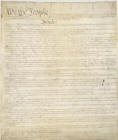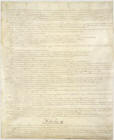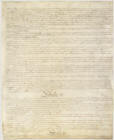|




United States Constitution 1787
You
will be thrilled to know that the exact measurements of the
originals of the Constitution of the United States are as
follows:
And here you can
 download high resolution images of the Constitution.
download high resolution images of the Constitution.
If you wish to see the
 Constitution with your own eyes, you are welcome to visit it at
Washington D.C.
Constitution with your own eyes, you are welcome to visit it at
Washington D.C.
And the best thing is, admission is free.
What is a
Constitution?
A constitution
defines the basic principles and laws of a nation.
When Was the
Constitution of the United States Created?
The deputies of the
Constitutional Convention assembled in
Philadelphia, in the State House where the
 Declaration of
Independence was signed. The meeting was called for May 14,
1787, but it took until May 25 until everybody had arrived.
Declaration of
Independence was signed. The meeting was called for May 14,
1787, but it took until May 25 until everybody had arrived.
The
Constitution was drafted in fewer than one hundred working days.
 George Washington,
chosen unanimously, presided over the Constitutional Convention.
George Washington,
chosen unanimously, presided over the Constitutional Convention.
The average age of the deputies to the Constitutional Convention was
about 44 years of age.
 Benjamin Franklin,
of Philadelphia, was the oldest member of the Constitutional
Convention with his 81 years. Jonathan Dayton, of New Jersey, was
the youngest member, being 26 years old. There were probably 34, out
of 55, who had at least made a study of the law.
Benjamin Franklin,
of Philadelphia, was the oldest member of the Constitutional
Convention with his 81 years. Jonathan Dayton, of New Jersey, was
the youngest member, being 26 years old. There were probably 34, out
of 55, who had at least made a study of the law.
Back then, Philadelphia had approx. a population of 28,000;
including its suburbs, about 42,000.
When Was the
Constitution Signed?
The U.S. Constitution was finally signed on September 17, 1787.
On the occasion, Benjamin Franklin gave his
 Address to the Constitutional Convention, advocating the
signing of the document.
Address to the Constitutional Convention, advocating the
signing of the document.
The Constitution was
ratified by the required number of states (nine) by June 21, 1788.
The U.S. National Archives and
Records Administration explains:
On March 3, 1789, the old Confederation went out of existence and on
March 4 the new government of the United States began legally to
function, according to a decision of the Supreme Court of the United
States (wings v. Speed, 5 Wheat. 420); however, it had no practical
existence until April 6, when first the presence of quorums in both
Houses permitted organization of Congress.
On April 30, 1789, George
Washington was inaugurated as President of the United States, so on
that date the executive branch of the government under the
Constitution became operative.
But it was not until February 2,
1790, that the Supreme Court, as head of the third branch of the
government, organized and, held its first session; so that is the
date when the US government under the Constitution became fully
operative.
What Was the Situation
Before the Constitution Took Effect?
The country's first constitution was the
Articles of Confederation.
The Articles were in effect from March 1, 1781,
until March 4, 1789.
In a Nutshell, What
are the Contents of the Constitution?
There are seven articles and a preamble.
Throughout the years several amendments were ratified.
The first 10 amendments, which constitute the
 Bill
of Rights, were added within two years of the signing of the federal
Constitution in order to ensure sufficient guarantees of individual
liberties; 27 amendments have been adopted.
Bill
of Rights, were added within two years of the signing of the federal
Constitution in order to ensure sufficient guarantees of individual
liberties; 27 amendments have been adopted.
In 1920, for instance, the Nineteenth
Amendment was added, giving women the right to vote.
About Thomas Jefferson
 Thomas Jefferson,
although absent from the Constitutional Convention and during the
period of ratification, rendered no inconsiderable service
to the cause of Constitutional Government, for it was partly through
his insistence that the Bill of Rights, consisting of the first ten
amendments, was adopted.
Thomas Jefferson,
although absent from the Constitutional Convention and during the
period of ratification, rendered no inconsiderable service
to the cause of Constitutional Government, for it was partly through
his insistence that the Bill of Rights, consisting of the first ten
amendments, was adopted.
About James Madison
 James Madison,
the delegate from Virginia, was called the Father of the Constitution.
How come? Because in point of erudition and actual
contributions to the formation of the Constitution he was
preeminent.
James Madison,
the delegate from Virginia, was called the Father of the Constitution.
How come? Because in point of erudition and actual
contributions to the formation of the Constitution he was
preeminent.
The Oldest Written
Constitution
The United States has the oldest written constitution among the
major nations of the world. All later Constitutions show its
influence; it has been copied extensively throughout the world.
Amendments to the U.S.
Constitution
The first ten
amendments came in 1791. They are called the
 Bill of Rights.
Bill of Rights.
 Amendments 11 to 27
were added between 1794 and 1992.
Amendments 11 to 27
were added between 1794 and 1992.
More History
|